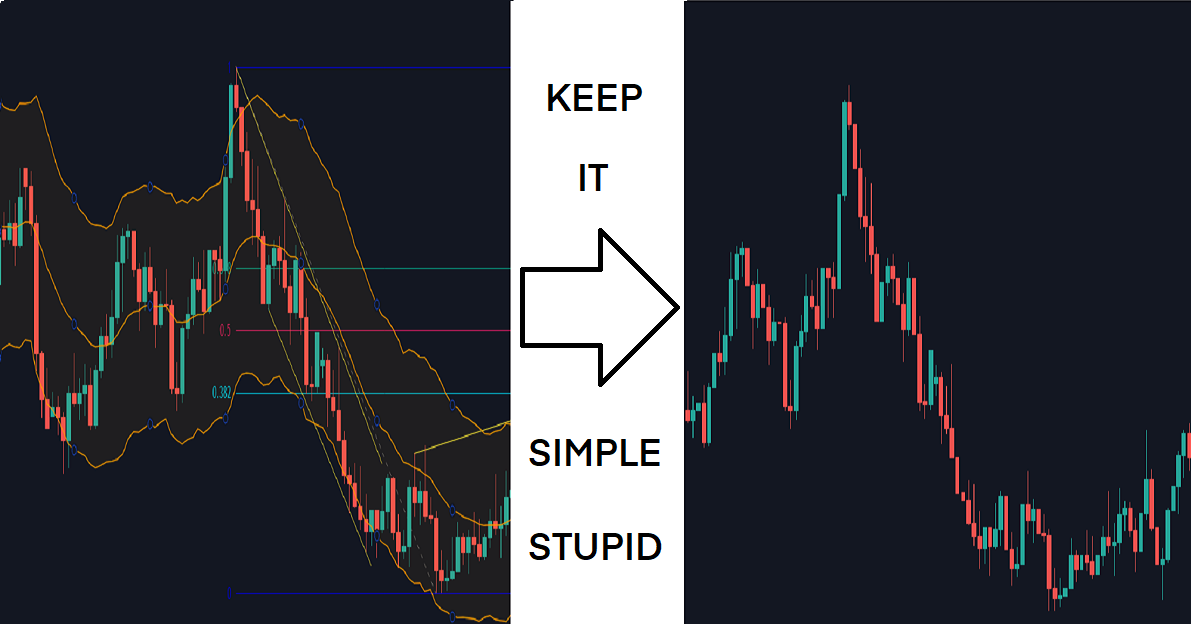Trading is the simplest game in the world, so why is it so hard to succeed?
How to apply the KISS principle to your trading
The KISS principle, first noted by the U.S. Navy in 1960, is a design concept that focuses on the role of simplicity. By avoiding unnecessary complexity, we can better design systems that function without issue. The acronym KISS stands for “Keep it simple stupid!”, and it couldn’t apply more to the game of trading.
Trading could well be the hardest, most complex game in the world. An estimated 80% of day traders quit within the first 2 years, many blowing up their accounts entirely, and few ever make the riches they long for when they start out.
Yet at the same time, the game of trading couldn’t be simpler. All you need to do is guess if price will hit point A (the target) before it hits point B (the stop loss). You can enter the trade whenever you want, but the closer you enter to where you’re wrong on the trade, the better the payoff will be. Bigger payoffs mean more points, which help you get ahead, and stay in the game longer.
So how does such a simple game feel so complex as soon as you start playing it?
Well for one, it’s a zero-sum game. So if you make money, someone else needs to lose it. You may think you’re just betting on price direction, but you’re betting against other players. And some of those players you’re up against have more money, more resources, more knowledge, more experience, and more edge than you.
What starts as a simple probabilistic game of betting higher or lower, soon evolves into a complex scenario of game theory, where you’re pitted against other rational agents whose future actions you must anticipate.
This makes for price action that can’t be trusted. Traps are everywhere. The market falsely advertises picture-perfect entries that quickly get flushed out. Price probes your stop loss with painful precision, and skims your target with frustrating imprecision.
To counter these challenging conditions, you use indicators, watch order flow, track correlations, and monitor for any news events that may impact price. You scale in and out of trades, hoping that at least a portion of the trade captures enough profit. You micromanage your positions in an attempt to escape the market’s punishment. But all these measures only add more complexity to the game.
Remember, all you need to do is guess whether price will hit point A or point B first. The best way to do this is by mastering these three skills:
- Recognising the invalidation point of a trade – where your trade idea has failed.
- Knowing the areas where price tends to struggle – where you should take profit.
- Understanding the optimal entry point to the trade – as close to the invalidation point as possible, without being so conservative that you always miss the fill.
If you can master these three things, you can master the game. But many instead get lost in needless complexity.
Follow these three tips to keep it simple, and avoid getting caught in the trap of overcomplication.
1. Use fewer indicators
Too many novice traders start using indicators from day one, without first being able to read naked price charts. With each indicator we add another layer of complexity to the game of trading. While there may be an edge in doing so, we should only do this once we have mastered the basics. Until you can read a price chart as naturally as you can read these words, avoid adding more complexity.
2. Don’t scale in and out
Scaling in and out is a trading approach where you enter and exit portions of the trade at different price points. Commonly you might scale in more to a long position as price moves lower, then scale out in portions as price moves further into profit.
You’ll hear strong opinions on whether you should do this or not. But looking at it through the lens of simplicity, what effect is having different positions with different entries and exits going to have on the complexity of the game?
It’s going to make it a lot harder to journal for a start. But worse is that your brain will have a harder time mastering the entry, stop loss, and target because you’ve just doubled or tripled the number of variables.
The trader who trades only one position sees the optimal entry and exit so much clearer than the trader who scales in and out of multiple positions. By keeping it simple and trading with an all-in all-out approach, you’ll learn exactly where the best entry and exit lies.
3. Adopt a no-management approach
Managing trades is an art. It takes years of experience to be able to manage trades in a way that leads to more profits over time. This is because price loves to test areas where stop losses are trailed, flushing out longs after big rallies and squeezing out shorts after big dumps. It also loves nothing more than to take out those who have prematurely trailed their stop to breakeven.
Like scaling in and out, adding management to your trading just increases the number of variables. This makes it harder to know what the optimal approach is. By sticking with a no-management approach, you keep things simple, and focus on the most important part of the game – will price hit point A before it hits point B?
The simpler your trading strategy is, with the fewest number of variables, the easier it’s going to be to track what works and what doesn’t. If ever in doubt, just remember the KISS principle, and “keep it simple stupid!”.

